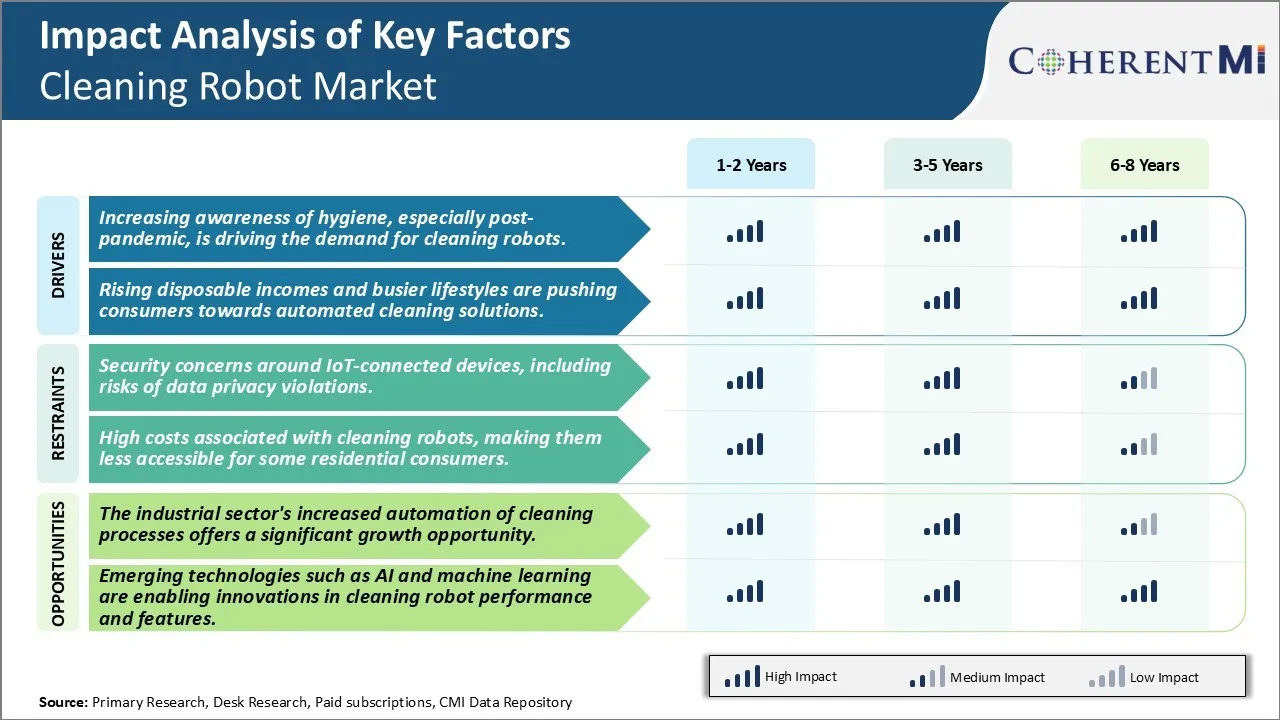Cleaning Robot Market SIZE AND SHARE ANALYSIS - GROWTH TRENDS AND FORECASTS (2024 - 2031)
Cleaning Robot Market is segmented By Type (Floor-cleaning, Pool-cleaning, Window-cleaning, Lawn-cle....
Cleaning Robot Market Trends
Market Driver - Increasing Awareness of Hygiene, Especially Post-Pandemic, is Driving the Demand for Cleaning Robots
The global pandemic has made consumers much more conscious about cleanliness and hygiene in both commercial as well as household spaces. Deep cleaning of surfaces on regular basis has become a necessity to curb the spread of viruses and other pathogens. However, performing thorough cleaning manually takes a significant amount of time and effort. Cleaning robots address this problem beautifully by automating the tedious process of cleaning floors, mopping, vacuuming and disinfecting on a scheduled basis without much human intervention. They can cover large areas thoroughly within a short time span, removing dirt, allergens, bacteria and viruses more effectively than manual cleaning. This assurance of hygienic spaces through consistent cleaning routines has become highly valued in the current environment. Cleaning robots are also found to be more practical than traditional cleaning methods as they eliminate the human error factor and ensure areas are cleaned precisely as programmed without any missed spots. Their uses are expanding beyond homes to hotels, hospitals and other commercial facilities where quality cleaning standards are of utmost importance. As hygienic indoor and public spaces assume greater importance than ever in a post pandemic world, the demand for reliable, easy to use cleaning robots is expected to grow substantially.
Market Driver - Rising Disposable Incomes and Busier Lifestyles are Pushing Consumers Towards Automated Cleaning Solutions
Modern lifestyles have become extremely fast paced and demanding. People have little time left for mundane chores like vacuuming, mopping, sweeping, washing and other cleaning activities. At the same, rising incomes have given consumers the bandwidth to invest in smart home devices that can make their lives more convenient by automating routine tasks. Cleaning robots fit right into this paradigm. They allow consumers to start cleaning cycles with just a tap on their smart devices and come back to cleaner spaces without any manual labor. This has become highly appealing given that most people today have extremely packed schedules leaving minimal time for domestic work. Cleaning robots quietly get the work done efficiently while families are away at work or engaged I other activities. Their advantages are even more emphasized in multi-storied homes and households with working couples or parents. By supplementing or entirely replacing manual cleaning routines with automated robot solutions, busy homeowners can reclaim several hours every week previously spent on cleaning for more valuable activities of their choice. The effortless 'set and forget' operation of modern cleaning robots is hence solving a real problem for time strapped consumers globally, driving up their sales numbers. With standards of living and disposable incomes continuing to rise across world regions, the demand for such labor saving appliances will keep accelerating.

Market Challenge - Security Concerns Around IoT-Connected Devices, Including Risks of Data Privacy Violations
One of the major challenges faced by the cleaning robot market is security concerns around IoT-connected devices, including risks of data privacy violations. As cleaning robots are integrated with internet connectivity to enable remote monitoring and control, it opens up possibilities of hacking and privacy breaches. Cleaning robots collect a variety of usage and location data as they operate inside homes and offices. If this usage data falls in the wrong hands, it can potentially be misused. There are also possibilities of ransomwares disabling or taking control of connected cleaning robots. This poses security risks. To address such security concerns, cleaning robot manufacturers will need to focus on implementing strong authentication protocols, encrypting the data collected, restricting physical access and conducting regular security audits. However, achieving robust security without diminishing user experience remains a challenge. Overall, unaddressed security vulnerabilities can undermine user trust in IoT-enabled cleaning robots and hamper growth. Manufacturers must work closely with cyber security experts to build confidence around data privacy and ensure safe usage of connected cleaning robots.
Market Opportunity- Industrial Automation Drives Further Growth Opportunities
The industrial sector's increased automation of cleaning processes offers a significant growth opportunity for the cleaning robot market. Industrial facilities such as manufacturing plants, warehouses and food processing units carry out extensive cleaning operations to ensure hygiene. Currently, most of the cleaning in industrial premises is done manually which is labor intensive, time-consuming and exposes workers to health hazards. Automated cleaning robots can render these operations more productive, hassle-free and safe. Robots can effortlessly clean large areas without breaks, efficiently handling tasks such as floor cleaning, scrubbing, disinfecting, parts cleaning and more. This improves productivity. They also ensure consistency in cleaning quality every time. With industries keen to maximize efficiency through technological upgrades, there exists ample scope for cleaning robot providers to automate varied cleaning needs of industrial facilities. This offers a promising avenue for cleaning robot makers to target and expand their market.